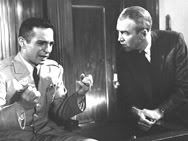Anatomy of a Murder 
Intercourse. Contraceptive. Spermatogenesis. Sexual climax. Panties. These were not the sort of words movie theatre audiences were used to hearing on the screen in 1959 but director Otto Preminger changed all that with his controversial courtroom drama, Anatomy of a Murder. It was a sure bet that the film's questionable dialogue would not pass through the Production Code office unnoticed but it wouldn't be the first time that Preminger had pushed the envelope with censorship issues in his movies. As early as 1951, he successfully challenged the Production Code over the right to use the word 'virgin' in the sex comedy, The Moon is Blue, and in 1955, he overcame opposition to his depiction of heroin addiction in The Man With the Golden Arm. Like the latter film, the more serious and compelling aspects of Anatomy of a Murder were overshadowed by the publicity surrounding the production which played up the more unsavory aspects of the rape/murder trial and sensationalized them. Yet, despite the adult subject matter, the film arrived on screens with its dialogue intact, became one of the biggest box office hits of that year, and went on to win seven Oscar nominations.
Based on the best-selling novel by Robert Traver, Anatomy of a Murder stars James Stewart as a small-town Michigan attorney who agrees to defend an Army lieutenant (Ben Gazzara) for killing the man accused of raping his wife (Lee Remick). With the help of his loyal support staff - Arthur O'Connell and the acerbic Eve Arden - Stewart carefully researches his case before going head to head with a slick prosecuting attorney (George C. Scott) from the big city.
Even before production began on Anatomy of a Murder, the film made front page headlines when Lana Turner, originally cast in the Lee Remick part, quit the film after a major altercation over costumes, though the actress later stated, "I would not walk out of a picture for anything as trivial as a costume. It was simply impossible to deal with Mr. Preminger's unpredictable temper." As for the part of the presiding judge in the film, Preminger offered the role to Spencer Tracy who turned it down as too small a part. Burl Ives also passed on the offer but then Spencer Tracy's assistant, Nat Rudich, came up with a great suggestion for Preminger - why not use a real judge? The director soon found the perfect 'actor' to play Judge Weaver - Joseph N. Welch, the eminent Bostonian who clashed with Senator Joseph McCarthy during the televised Un-American Activities hearings over communist activity in the U.S.
Anatomy of a Murder was filmed on location in two small towns in Michigan - Ishpeming and Marquette - over an eight week period. The director also arranged for the film's composer to be present during part of the filming. In his autobiography (1977, Doubleday), Preminger wrote, "Our presence created great excitement in those little towns. The special train carrying cast, crew, and equipment arrived at six-thirty on a March day, but half the population was at the station to greet us. Duke Ellington arrived a few days after we had begun to shoot. Usually the producer waits until the filming and the first cut are completed, then he chooses the composer, who writes the score in about six weeks. I find it useful to have the composer with me on the set. By watching the progress of the shooting, seeing the dailies....he becomes part of the film...Ellington was willing to sacrifice his valuable time and work according to my system." The director even cast him in a bit part - as a pianist named 'Pie-Eye,' working at the local roadhouse. The soundtrack album marked Ellington's first film score in 25 years and the main theme was later turned into a song with lyrics by Peggy Lee entitled "I'm Gonna Go Fishin'".
Of all the film's many virtues, James Stewart's portrayal of attorney Paul Biegler is a key factor in the film's success. According to the actor, he considered it his most challenging role since Frank Capra's It's a Wonderful Life (1946). "It was worth all the extra effort," Stewart said in Roy Pickard's Jimmy Stewart: A Life in Film (St. Martin's Press). "I spent a lot of time memorizing my lines for that movie. The picture demanded an awful lot of time and thought. As the defense attorney I knew I had to be glibber than usual. Trial lawyers are neither shy nor inarticulate. I read my script each night until I fell asleep." Co-star George C. Scott also confirmed Stewart's dedication to the role in Pickard's biography: "Jim was very kind in rehearsing...but what I didn't expect and what stunned me was what happened after we'd finished the coverage on Jim and the camera turned around on me. Some actors have a tendency to...sort of phone it in from there. But not Mr. Stewart...(he) came and stood by the camera and performed for me alone. It was a lesson I've never forgotten."
Not surprisingly, James Stewart received an Academy Award nomination for Best Actor for his performance in Anatomy of a Murder (he lost to Charlton Heston for Ben-Hur) and would go on to play another small-town lawyer in the TV series, Hawkins (1973-1974). In addition to Stewart, Anatomy of a Murder received Oscar nominations for Best Picture, Best Supporting Actor (Arthur O'Connell and George C. Scott), Best Screenplay, Best Film Editing, and Best Cinematography, but lost in every category.
Producer/Director: Otto Preminger
Screenplay: Robert Traver (novel), Wendell Mayes
Production Design: Boris Leven
Cinematography: Sam Leavitt
Film Editing: Louis R. Loeffler
Original Music: Duke Ellington
Cast: James Stewart (Paul Biegler), Lee Remick (Laura Manion), Ben Gazzara (Lieutenant Manion), Arthur O'Connell (Parnell McCarthy), Eve Arden (Maida Rutledge), George C. Scott (Claude Dancer), Kathryn Grant (Mary Pilant), Orson Bean (Dr. Smith), Murray Hamilton (Paquette).
BW-161m.
by Jeff Stafford